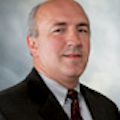Beyond PID: how software-defined automation is converging IT/OT and empowering edge intelligence
Key highlights
- Software-defined automation offers machine builders greater flexibility in selecting hardware with the right price, ruggedness and capacity for specific applications.
- This approach allows for the integration of new, high-capacity control into existing architectures without requiring a complete overhaul, preserving investments in legacy systems.
- The shift toward software-defined controllers and edge devices will bring more compute power closer to the machinery, enabling the implementation of advanced AI/ML techniques for enhanced control and optimization.
Sean Saul is the vice president of product at Emerson’s process systems and solutions business, where he is responsible for leading the overall product direction for the DeltaV distributed control system and safety instrumented system platforms.
Since joining Emerson in 2012, Saul has held multiple leadership roles across sales, marketing and strategy functions. He holds a bachelor’s degree in electrical engineering from the University of Texas at Dallas and a master’s degree in business administration from the University of Texas at Austin.
What is the primary focus of software-defined automation (SDA)?
Sean Saul, vice president of product, process systems and solutions business, Emerson: As companies’ operating philosophies shift toward more flexible manufacturing, they need improved technology options so they can continually reconfigure and innovate to meet market demands. The traditional controls engineering methodology of “design once, build once, run forever” is no longer sustainable. Software-defined automation is designed to provide users more flexibility than traditional control technologies by abstracting software applications from specific hardware platforms, delivering productivity and reduced costs throughout the lifecycle of a facility.
As an example, software-defined control allows flexibility for where control workloads run, as systems are no longer tied to specific hardware configurations. With potentially more compute resources, control can move beyond existing function blocks—it could be running more sophisticated AI/ML techniques directly on the same hardware as the PIDs.
What are the primary benefits of software-defined automation?
Sean Saul, vice president of product, process systems and solutions business, Emerson: Software-defined automation is more flexible— running on a wider variety of hardware platforms and allowing more compute power at the edge than ever before. It is also incredibly adaptive, with effortless scalability as components are added or upgraded in a virtual environment. Each of these factors contributes to higher productivity and lower costs across the lifecycle of manufacturing facilities.
How does software-defined automation figure in the convergence of IT and OT?
Sean Saul, vice president of product, process systems and solutions business, Emerson: Software-defined automation will accelerate the trend of IT/OT convergence as the clear lines that currently define responsibilities, often set by the Purdue Model, continue to blur. Many of our customers currently have manufacturing technology organizations combining the skillsets of IT and OT experts to achieve objectives that often compete: scale and efficiency (IT) vs. availability and resilience (OT). The promise of software-defined automation is these objectives will no longer trade off against each other, driven by a common technology foundation designed with the resilience that mission-critical production applications demand.
Which components will see the biggest impact from software-defined automation?
Sean Saul, vice president of product, process systems and solutions business, Emerson: Edge devices, industrial PCs and controllers will all benefit from a more software-defined approach. The demand for more compute power at the edge is key to the coming wave of AI technologies that will create a paradigm shift in manufacturing. There is no denying that AI technology will create many new opportunities for innovation, but the latest workloads cannot be run on legacy control hardware, nor can they be deployed exclusively in a cloud environment. Software-defined controllers and edge devices will bring the necessary compute power closest to the underlying manufacturing process, unlocking the ability to drive competitive advantage in an increasingly complex and competitive global marketplace.
In what ways does software-defined automation allow machine builders more flexibility in hardware selection and management?
Sean Saul, vice president of product, process systems and solutions business, Emerson: Software-defined automation allows machine builders more options to specify the right hardware for the application. It will be easier to ensure hardware is in the right price range, with the right amount of ruggedness and the right capacity, small or large, with more flexible architecture.
Get your subscription to Control Design’s daily newsletter.
How does software-defined automation build on existing IT and network infrastructure in factories and plants?
Sean Saul, vice president of product, process systems and solutions business, Emerson: With the best modern software-defined controllers, teams can integrate new control capacity in among their existing control technologies that are already there, leveraging the same tools and interfaces for both their software-defined controllers and the legacy controllers. This eliminates the need to rip and replace existing architecture to gain the benefits of new technologies. Teams can leave the legacy control technologies that work in place and use them in parallel, seamlessly, with their new controllers.
Tell us about your company’s state-of-the-art product that involves software-defined automation.
Sean Saul, vice president of product, process systems and solutions business, Emerson: Emerson is developing a flexible, high-capacity software-defined controller designed for online, mission-critical operations. By deploying control workloads within a server-based environment, this new controller will simplify engineering, maintenance and upgrades while significantly reducing footprint and increasing scalability.
With twice the control capacity of a traditional controller, a single pair of servers can handle the control requirements of most large-scale facilities. The new software-defined controller will provide even more flexibility across the DeltaV system allowing control workloads to be distributed across traditional controllers and controllers hosted in a server-based environment, all seamlessly managed by the same tools our customers utilize today.
Next steps
- Research new software-defined controllers to understand specific capabilities and integration options for machinery designs.
- Evaluate current hardware specifications and control architectures to identify potential applications where software-defined automation could offer cost savings or performance improvements.
- Initiate a conversation with the IT department to discuss the implications and opportunities presented by the convergence of IT and OT through software-defined automation.
About the Author
Mike Bacidore
Editor in Chief
Mike Bacidore is chief editor of Control Design and has been an integral part of the Endeavor Business Media editorial team since 2007. Previously, he was editorial director at Hughes Communications and a portfolio manager of the human resources and labor law areas at Wolters Kluwer. Bacidore holds a BA from the University of Illinois and an MBA from Lake Forest Graduate School of Management. He is an award-winning columnist, earning multiple regional and national awards from the American Society of Business Publication Editors. He may be reached at [email protected]


